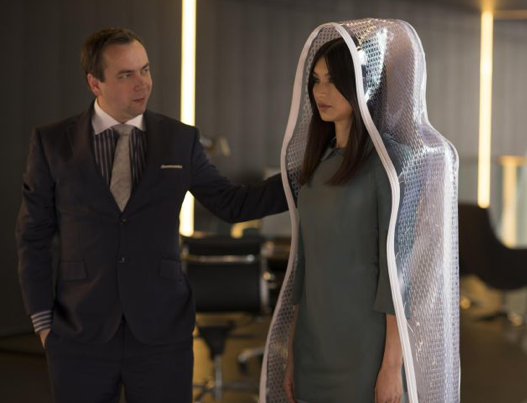The zeitgeist seems to be moving from zombies to another form of the undead – robots. Don’t know if you’ve seen the TV series Humans, but it touches on the key theme of what’s real (human) and what isn’t wonderfully. Reminds me of something I wrote for Future 50 a while back. Oh the image above? Just an early view of the shape of things to come!
—
‘Uncanny resemblance’ is a term often used to describe something or, more usually, someone, who looks strangely or spookily familiar. In robotics the term ‘Uncanny Valley’ is used to describe how people instinctively reject robots that look too much like human beings, the valley in question being a trough in a graph showing robot rejection and acceptance.
The word ‘robot’ comes from the Czech word, meaning ‘servitude’, although some translations use the terms ‘obligatory work’, ‘forced labour’ or ‘drudgery’. Most popular visions of the future include robots, often with human-like forms, and with other features mimicking human height, eyes, limbs, movement and even human conversation. But this is precisely where the trouble starts. We have become accustomed to the idea of robots making other machines, cars, for example, and we are now getting used to robots in the form of cuddly toys, lawnmowers, vacuum cleaners and bomb-disposal machines. The Japanese are apparently even getting used to R2-D2-like nursery assistants and aged care robots. But what happens when someone builds a humanoid-like bot that looks and acts like, well, one of us? To some extent we already know.
In Japan, for example, Dr Hiroshi Ishiguro has created a robot that looks like … Dr Ishiguro. The resemblance is uncanny, prompting an uncomfortable reaction from observers, especially as ‘he’ is sporting the same glasses and wears the same clothes. From a distance you can hardly tell the difference. Interestingly, the idea of such robots tends to be rejected by adults, but is often accepted by young children. Not all young children, though. Before he made a robotic copy of himself, Dr Ishiguro made a lifelike copy of his four-year-old daughter. She was so upset after seeing it that she refused point blank to enter her father’s laboratory in case she encountered it again. As to what will happen if robots become so life- like in appearance and mannerisms that you really cannot tell the difference, that’s anyone’s guess.
Psychologically speaking, we recognize certain types of robot as lifelike – meaning human lifelike – and then we suddenly notice various non-human features or characteristics, which leads to feelings of unease, alienation and even disgust. Perhaps the same could be said of our reactions to dead bodies. Cartoon characters, cartoon-like avatars and cuddly toys, in contrast, do not present the same level of threat because they are not trying to trick us into believing they’re human. Perhaps this is linked to some kind of ancient species preservation or protection instinct. Or maybe we’ve all just been watching too much tech-noir science fiction? Some people totally reject the whole hypothesis, arguing that it’s ridiculous to reduce human authenticity to a single measurement on a graph, but as robotics, virtual reality, artificial intelligence, computer animation and synthetic biology all converge, this debate will get quite complex. This fact has not escaped the attention of artists, such as Patricia Piccinini, who has created human-hybrid sculptures and other controversial artworks. And if you think Patricia’s work is a little disturbing, have a look at the reborn‘dolls’ created by the photographer Rebecca Martinez for a project called ‘pretenders’ or the ‘lifelike’ artworks of Ron Mueck.
But apart from these controversies, what else can we expect from robots in the near future? At the moment the robotics industry is fragmented, with a plethora of standards and platforms, much like the computer industry was in the 1970s. Currently, most robots are also low-volume niche products, ranging from bomb-disposal and surveillance robots used by the military to domestic robots that cut the lawn or sweep the floor. But this will change due to the convergence of a handful of trends. First, the cost of computing power (processing and storage) is dropping fast. Second, distributed computing, voice and visual recognition technologies and wireless broadband connectivity are similarly dropping in price and increasing in availability.
Personal robots could soon be dispensing medicine, folding laundry, teaching kids and keeping an eye open for intruders. There could also be some less obvious uses for robots, especially in customer service roles. For instance, robots could carry your shopping bags in a supermarket or your suitcases in a hotel. They could replace guide dogs for visually impaired people or take over from care workers in nursing homes. Whether a machine will ever fully replace human or animal contact is a big question and will in large part depend on what these robots look like. However, attitudes may shift, especially if humanoid robots start to display synchronous behaviour (e.g. they mimic human gestures) and can learn to be emotional. As for whether people could form strong relationships with robots, that’s an open question, although our experience with animals might suggest that we will.
There is little evidence of any inner consciousness in domesticated animals, but we often treat them almost like human companions. Perhaps, by 2050, we will regularly have relationships with robots and even end up, in some cases, marrying them


